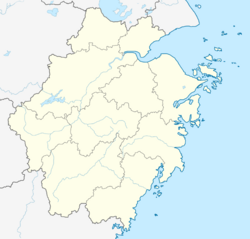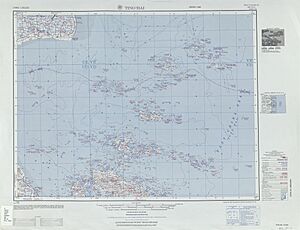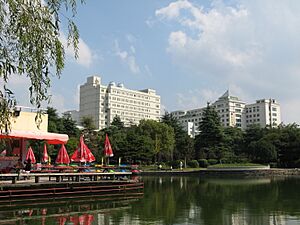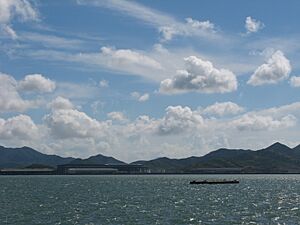Dinghai, Zhoushan facts for kids
Quick facts for kids
Dinghai
定海区
Tinghai
|
|
|---|---|
|
District
|
|
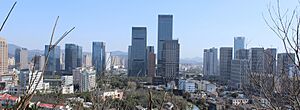
Zhoushan New Town
|
|
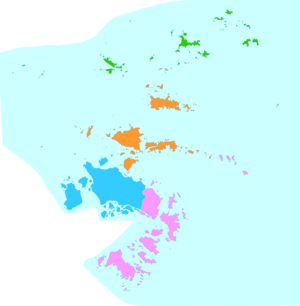
Dinghai District is in blue here on the map.
|
|
| Country | People's Republic of China |
| Province | Zhejiang |
| Prefecture-level city | Zhoushan |
| Seat | Changguo Subdistrict |
| Area | |
| • Total | 1,444.0 km2 (557.5 sq mi) |
| • Land | 568.8 km2 (219.6 sq mi) |
| • Water | 875.2 km2 (337.9 sq mi) |
| Population
(2019)
|
|
| • Total | 399,382 |
| • Density | 276.580/km2 (716.340/sq mi) |
| Time zone | UTC+8 (China Standard) |
| Postal code |
316000
|
| Dinghai | |||||||||
|---|---|---|---|---|---|---|---|---|---|
| Chinese | 定海 | ||||||||
| Postal | Tinghai | ||||||||
|
|||||||||
Dinghai (simplified Chinese: 定海区; traditional Chinese: 定海區; pinyin: Dìnghǎi Qū) is a district in Zhoushan City, Zhejiang province, China. It is made up of 128 islands! The total area of Dinghai is about 1,444 square kilometers. This includes 568.8 square kilometers of land and 875.2 square kilometers of sea. Its coastline stretches for over 400 kilometers.
Dinghai is located on the northwestern part of Zhoushan Island. It shares a border with Putuo to the east. To the north, its sea boundary meets Daishan County. In the southwest, its sea boundary touches Ningbo. Dinghai became a district in January 1987. As of 2019, about 399,382 people live there.
Contents
A Glimpse into Dinghai's Past
People have lived in the Dinghai area for over 5,000 years. That's a very long time!
Early Names and Changes
During the Spring and Autumn period, this area was called Yongdong (simplified Chinese: 甬东; traditional Chinese: 甬東). It was part of the Yue state.
In 738 CE, it became Wenshan County (simplified Chinese: 翁山县; traditional Chinese: 翁山縣). But in 771 CE, it was no longer a county. It was then managed by Mao County.
Later, in 1073, the area was named Changguo County (simplified Chinese: 昌国县; traditional Chinese: 昌國縣). It was under the control of Ming Prefecture.
The name Dinghai County (simplified Chinese: 定海县; traditional Chinese: 定海縣) was first used in 1688. This was during the time of the Qing Dynasty.
Dinghai During Wars
During the First Opium War, British forces took control of Dinghai on July 6, 1840. It was given back for a short time. However, it was taken again by British forces on October 1, 1841.
Much later, on May 17, 1950, the People's Liberation Army took control of Dinghai.
Modern Changes
In October 1958, Zhoushan's special status was removed. Dinghai became part of Zhoushan County. But in April 1962, Zhoushan got its special status back. Dinghai County was also re-established.
Finally, in January 1987, Dinghai County officially became Dinghai District.
Exploring Dinghai's Geography
Dinghai District covers a total area of 1,444.0 square kilometers. About 568.8 square kilometers is land, and 875.2 square kilometers is sea. It is located in the northeast of Zhejiang Province. It is also southeast of Shanghai, near Hangzhou Bay and the outer edge of the East China Sea.
Islands and Mountains
Dinghai is made up of 128 islands! Some of the main islands include Zhoushan Island, Jintang Island, and Damao Island (Chinese: 大猫岛). Other islands are Cezi Island, Changbai Island, and Aoshan Island. You can also find Changzhi Island (Chinese: 长峙岛) and Panzhi Island (Chinese: 盘峙岛).
Many of these islands have hills. The highest point in Dinghai is Huangyanjian Mountain (Chinese: 黄杨尖山). It stands tall at 503.6 meters!
Wildlife and Nature
The waters around Dinghai are full of marine life. You can find about 80 different kinds of fish. There are also over 150 types of shellfish.
Rare birds also live here. These include the endangered black-faced spoonbill, the yellow-billed egret, and the horned grebe.
Dinghai's Climate
Dinghai has a marine monsoon climate. This means it has mild winters and cool summers. The weather is generally gentle and humid. It also gets plenty of sunshine.
The average temperature in Dinghai is 16.8 °C. January is the coldest month, with an average of 6.2 °C. August is the warmest, averaging 27.4 °C. The coldest temperature ever recorded was −4.2 °C on December 28, 1991. The warmest was 40.2 °C on July 21, 2007.
Dinghai gets about 1410.8 millimeters of rain each year. It has about 149 rainy days annually.
Sometimes, the area experiences typhoons, heavy rains, floods, and droughts. On March 12, 2005, a big blizzard hit. It brought the most snowfall since 1978!
How Dinghai is Organized
Dinghai District is divided into 10 subdistricts and 3 towns. As of 2019, these areas are further split into smaller parts. There are 41 residential communities, 73 rural villages, and 7 urban villages.
| English Name | Subdivision Type | Chinese Name | Population (2019) |
|---|---|---|---|
| Changguo Subdistrict | Subdistrict | Chinese: 昌国街道; pinyin: Chāngguó Jiēdào | 54,457 |
| Huannan Subdistrict | Subdistrict | Chinese: 环南街道; pinyin: Huánnán Jiēdào | 34,874 |
| Chengdong Subdistrict | Subdistrict | Chinese: 城东街道; pinyin: Chéngdōng Jiēdào | 51,578 |
| Yancang Subdistrict | Subdistrict | Chinese: 盐仓街道; pinyin: Yáncāng Jiēdào | 19,600 |
| Lincheng Subdistrict | Subdistrict | Chinese: 临城街道; pinyin: Línchéng Jiēdào | 46,886 |
| Cengang Subdistrict | Subdistrict | Chinese: 岑港街道; pinyin: Céngǎng Jiēdào | 18,063 |
| Ma'ao Subdistrict | Subdistrict | Chinese: 马岙街道; pinyin: Mǎ'ào Jiēdào | 9,653 |
| Shuangqiao Subdistrict | Subdistrict | Chinese: 双桥街道; pinyin: Shuāngqiáo Jiēdào | 18,170 |
| Xiaosha Subdistrict | Subdistrict | Chinese: 小沙街道; pinyin: Xiǎoshā Jiēdào | 19,802 |
| Qiandao Subdistrict | Subdistrict | Chinese: 千岛街道; pinyin: Qiāndǎo Jiēdào | 39,189 |
| Jintang | Town | Chinese: 金塘镇; pinyin: Jīntáng Zhèn | 40,074 |
| Baiquan | Town | Chinese: 白泉镇; pinyin: Báiquán Zhèn | 37,144 |
| Ganlan | Town | Chinese: 干𬒗镇; pinyin: Gānlán Zhèn | 9,892 |
People and Economy
Population in Dinghai
In 2019, Dinghai District had a population of 399,382 people. This was a small increase from the year before. For every 100 females, there were about 96.58 males.
Back in the year 2000, a census showed that the district had 369,448 people.
Dinghai's Economy
In 2011, the total value of goods and services produced in Dinghai (its GDP) was ¥31 billion. This shows the economic activity in the district.
Famous People from Dinghai
- Qiao Shi – a well-known political figure.
- San Mao – a famous writer.


